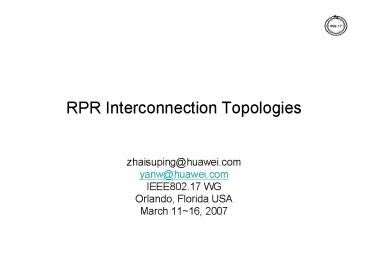RPR Interconnection Topologies - PowerPoint PPT Presentation
Title:
RPR Interconnection Topologies
Description:
Use the xSTP (or variation) may realize fast failover time. ... of network deployment flexibility outweighs the cost, then the Topology ... – PowerPoint PPT presentation
Number of Views:60
Avg rating:3.0/5.0
Title: RPR Interconnection Topologies
1
RPR Interconnection Topologies
- zhaisuping_at_huawei.com
- yanw_at_huawei.com
- IEEE802.17 WG
- Orlando, Florida USA
- March 1116, 2007
2
Two Basic RPR Interconnection Topologies
Topology A
Topology B
3
The Comparison of Two Topologies
4
The Comparison of Two Topologies Cont.
Tentative Conclusion (need further discussion)
When the requirement of network deployment
flexibility outweighs the cost, then the Topology
B is used, or else the Topology A is recommended
in the RPR interconnection rings network.
5
The following slides will illustrate the
different application scenarios for the
interconnected RPR rings. The following figures
take the Topology A as example, but the same
topologies also apply to Topology B as well.
6
Application Scenario 1
- There are several subtending rings across one
ring. - Each pair of interconnected stations (A, B
and C,D) are independent - and belong to different protection groups.
7
Application Scenario 2
- There are several subtending rings across one
ring, and these subtending rings share a common
station. - Each pair of interconnected stations (A, B
and B, C) are independent and belong to
different protection groups.
8
Application Scenario 3
- There are several subtending rings across one
ring, and these subtending rings share the same
interconnection stations. - For the usual deployment, subtending access
rings are not communicated each other, they only
need to communicate with the aggregation rings. - But if the subtending access rings need to
communicate each other, they still can at the
cost of some implementation complexity.
9
Application Scenario 4
- We dont want support this disordered
topologies. Do we want?
10
Thank you































